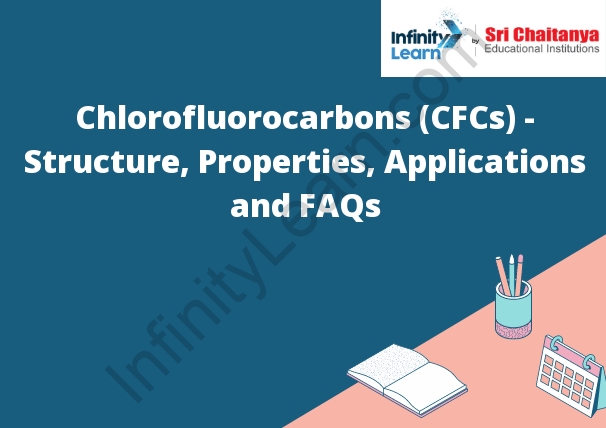Table of Contents
What are Chlorofluorocarbons?
Chlorofluorocarbons are a group of chemicals that contain carbon, chlorine, and fluorine. They used in a variety of applications, including as refrigerants, aerosol propellants, and solvents. Chlorofluorocarbons potent greenhouse gases and are believed to contribute to global climate change.

What is CFC Gas?
CFC gas is an abbreviation for chlorofluorocarbon gas. It is a gas that composed of chlorine, fluorine and carbon atoms. CFC gas is a colorless, odorless and non-flammable gas. It was once commonly used in aerosol cans, refrigerators and air conditioners. However, it has found to a potent greenhouse gas and is now banned in many countries.
Chlorofluorocarbon Structure
Chlorofluorocarbons are a type of organic compound that contain carbon, chlorine, and fluorine atoms. They have a C-Cl-F bond and a tetrahedral molecular geometry. Chlorofluorocarbons used as refrigerants, solvents, and propellants. They are non-toxic and non-flammable.
Properties of Chlorofluorocarbons
Chlorofluorocarbons (CFCs) are a type of synthetic compound that was once used in a variety of products, including aerosol cans, air conditioners, and refrigerators. They are nontoxic and have a low boiling point, which makes them ideal for use in these products. However, CFCs also potent greenhouse gases, and their use phased out in the 1990s after it discovered that they contribute to global warming.
Preparation of Chlorofluorocarbons CFCs
Chlorofluorocarbons (CFCs) compounds made of chlorine, fluorine, and carbon. They used as refrigerants, propellants, and solvents.
To prepare CFCs, first chlorinate an alkane. Add F2 gas to the mixture, and then heat the reaction.
Applications of Chlorofluorocarbons
Chlorofluorocarbons have a variety of applications. Therefore they often used as refrigerants in air conditioners, refrigerators, and freezers. They are also used as propellants in aerosol cans and as solvents in cleaning products.
Chlorofluorocarbons and Ozone Depletion
Chlorofluorocarbons (CFCs) are a type of synthetic compound that was once commonly used in aerosol cans, refrigerators, and air conditioners. However, it has found that when CFCs released into the atmosphere, they can deplete the ozone layer.
The ozone layer is a layer of the Earth’s atmosphere that helps to protect us from the sun’s harmful ultraviolet radiation. When CFCs released into the atmosphere, they can interact with the ozone layer and cause it to thin. This can lead to an increase in the amount of ultraviolet radiation that reaches the Earth’s surface, which can cause health problems for people and animals.
CFCs have banned in many countries since the mid-1990s because of their contribution to ozone depletion.
Frequently Asked Questions About Chlorofluorocarbons (CFCs):
In this article, we will address some frequently asked questions about CFCs to provide a better understanding of their impact on the environment.
Question 1: What are Chlorofluorocarbons (CFCs)?
Answer 1: Chlorofluorocarbons (CFCs) are chemical compounds that contain carbon, chlorine, and fluorine atoms. They are typically used as refrigerants, aerosol propellants, foam-blowing agents, and solvents. CFCs are stable, non-toxic, and non-flammable, making them suitable for various applications.
Question 2: What makes CFCs harmful to the environment?
Answer 2: Although CFCs are relatively safe for human health, they pose a significant threat to the environment. When released into the atmosphere, CFCs can rise to the stratosphere where they break down due to sunlight, releasing chlorine atoms. These chlorine atoms catalytically destroy ozone molecules, leading to the thinning of the ozone layer—a protective shield that filters out harmful ultraviolet (UV) radiation from the sun.
Question 3: How do CFCs contribute to climate change?
Answer 3: In addition to ozone depletion, CFCs also have a potent greenhouse effect, contributing to global warming. While their direct impact on climate change is relatively low compared to other greenhouse gases, CFCs have a high global warming potential (GWP) due to their long atmospheric lifetimes. Once released, CFCs can persist in the atmosphere for several decades, trapping heat and increasing the Earth’s temperature.
Question 4: What is the Montreal Protocol, and why is it significant?
Answer 4: The Montreal Protocol is an international environmental agreement adopted in 1987 to regulate the production and use of substances that deplete the ozone layer, including CFCs. It has been ratified by nearly all countries and has successfully led to a significant reduction in global CFC emissions. The protocol is considered a landmark achievement in global environmental cooperation.
Question 5: What are the alternatives to CFCs?
Answer 5: To replace CFCs, alternative substances known as hydrochlorofluorocarbons (HCFCs) and hydrofluorocarbons (HFCs) were developed. While these alternatives have lower ozone depletion potential, they still contribute to global warming. More environmentally friendly substitutes, such as hydrofluoroolefins (HFOs) and natural refrigerants like ammonia and carbon dioxide, are gaining popularity.








